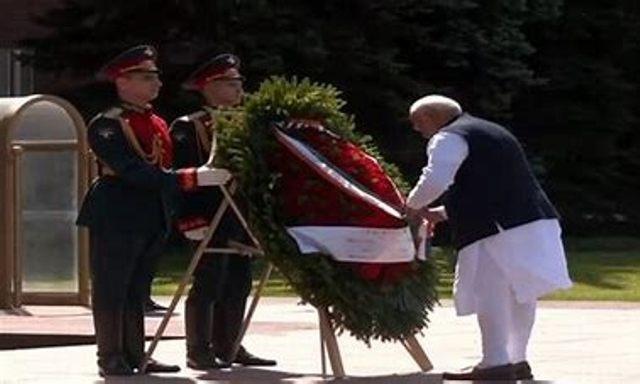Moscow: Prime Minister Narendra Modi, who is on a two-day visit to Russia, laid a wreath at the Tomb of the Unknown Soldier in Moscow on Tuesday and paid his tributes.
The Tomb of the Unknown Soldier is a war memorial located at the Kremlin Wall in Moscow and is dedicated to the Soviet soldiers who lost their lives during World War II.
The monument, built in memory of the millions of missing and deceased Russian soldiers after World War II, was unveiled on May 8, 1967.
Since December 3, 2014, Russia has commemorated the Day of the Unknown Soldier in their honour. In 1997, the Guard of Honour of the Kremlin Regiment, previously tasked with guarding the Lenin Mausoleum, was reinstated at the Tomb of the Unknown Soldier by a federal law enacted on December 8, 1997.
This tomb hosts a Changing of the Guard ceremony every hour. The memorial features a dark red porphyry monument decorated with a bronze sculpture of a laurel branch and a soldier’s helmet placed upon a banner, designed by architects DI Burdin, VA Klimov, Yu R Rabayev, and sculptor Nikolai Tomsky.
Placed in front of the monument is a five-pointed star in a square field of labradorite, from which the Eternal Flame emanates. This flame, transferred from the Eternal Flame at the Monument to the Fighters of the Revolution in Saint Petersburg, illuminates a bronze inscription that reads, “Имя твоё неизвестно, подвиг твой бессмертен” (transliteration: Imya tvoyo neizvestno, podvig tvoy bessmerten, meaning “Your name is unknown, your deed is immortal”).
The tradition of Tombs of the Unknown Soldier originated in France and Britain in 1920 and spread worldwide after World War II. Today, over 50 countries have such memorials, which have become national shrines symbolising the collective grief and pride of nations.
These tombs honour unidentified soldiers who sacrificed their lives, ensuring their deeds are remembered even if their names are not. These memorials serve both national and individual mourning purposes. They provide a place for bereaved families to honour their loved ones and for nations to pay tribute to their heroes.
The Tomb of the Unknown Soldier in Russia serves as a poignant reminder of the sacrifices made during World War II. Despite the unprecedented number of casualties in the war, victorious and defeated nations alike agreed that every fallen soldier deserved proper burial and recognition.
The challenge of identifying remains was widespread due to the extent of the destruction, making the Tomb of the Unknown Soldier concept a fitting solution to create a national symbol for the unidentified fallen and allowing families to mourn as if the unknown soldier were their own loved one.


















